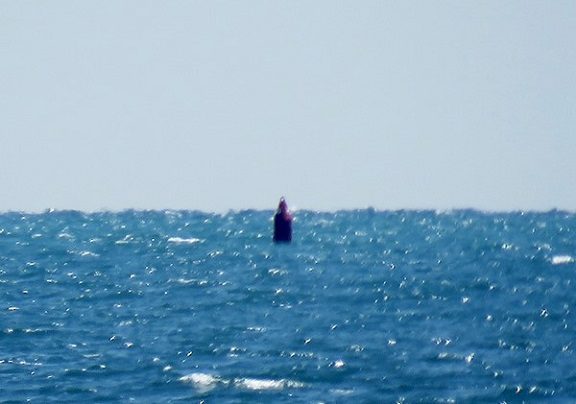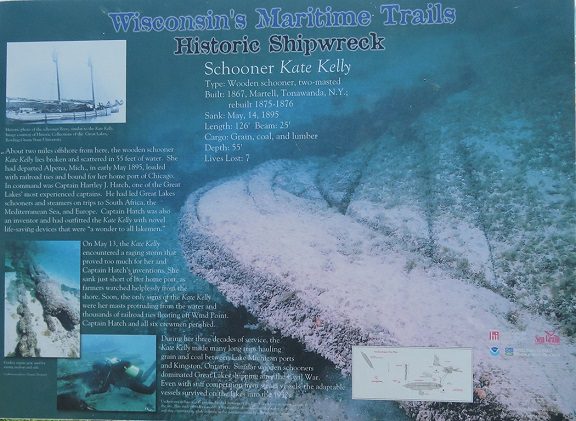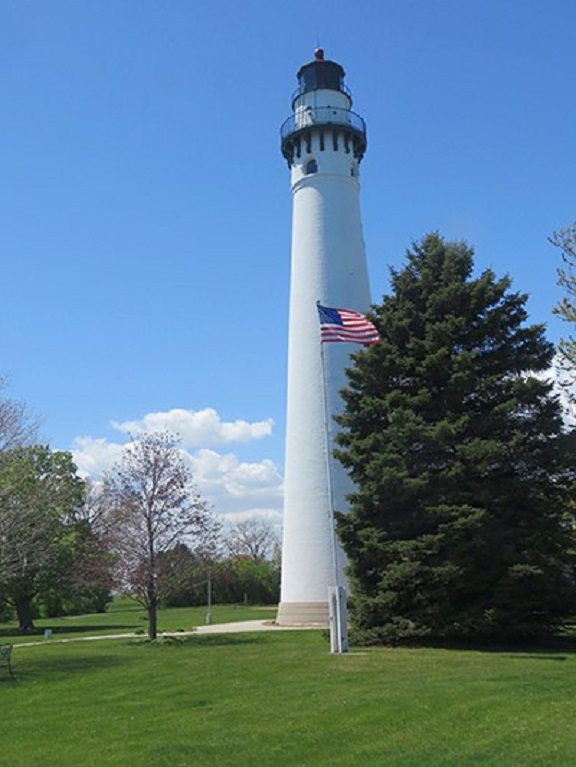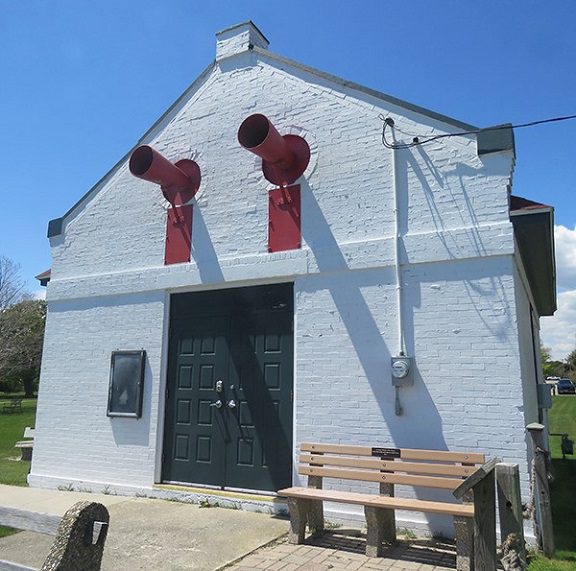In Honor of NATIONAL HISTORIC MARKER DAY we are reprinting the story of the schooner KATE KELLY and her Historical Marker located at Wind Point Lighthouse in Racine. A location certainly worthy of a visit and a walk on the Lake Michigan beach.
Photo at the top of the page: The Wisconsin Maritime Trails Marker of the KATE KELLY is on the grounds of the Wind Point Lighthouse, near Racine. The Lake Michigan wreck of the schooner is about two miles offshore in about fifty-feet of water. Photo Credit: Carl Eisenberg.
Writer has flashback mulling the sinking of two-masted schooner off Wind Point Lighthouse in 1895
By Carl Eisenberg, May 18, 2021
Two miles offshore of the Wind Point Lighthouse is the wreck of the schooner KATE KELLY. She sank with her crew in Lake Michigan in 1895.

The wreck of the schooner KATE KELLY is about two miles offshore in about fifty-five feet of water. The Wisconsin Historical Society’s red mooring buoy is directly above the wreck. Photo Credit: Carl Eisenberg.
The ship’s remains rest in about fifty-five feet of water. A Wisconsin Historical Society red mooring buoy marks the spot. The wreckage is a favorite for beginning divers who tie up to the seasonal buoy, allowing them a safe way to reach the wreck without having to use an anchor that might damage the archaeological relic.
That piece of history is about an hour’s drive south of my home in Mequon. One route to the Wind Point Lighthouse grounds is Wisconsin Highway 32, otherwise known as the 32nd Division Memorial Highway.

The Wisconsin Historical Society marker chronicles the history of the KATE KELLY. Photo Credit: Carl Eisenberg.
On land the wreck is chronicled on a Wisconsin Maritime Trails Marker.
Visiting these grounds of the Wind Point Lighthouse and the marker is an easy day trip from Milwaukee, and there is a lot to see.

Standing 108 feet high, the Wind Point Lighthouse is at the north end of Racine Harbor in Wisconsin. Photo Credit: Carl Eisenberg.
The two-masted wooden KATE KELLY is 126 foot long, 26 foot wide, built in 1867 by John Martel in Tonawanda, N.Y. She was narrow enough, by four inches, to get through the Welland Canal. She had a series of owners until 1867 when a group purchased her, moving her home port from Buffalo to the Oswego, N.Y., port. Part-owner Captain Robert Hayes took command and served until KATE KELLY was auctioned in November, 1897. She changed hands again in March of 1893, and this time her owner became Captain Hartley J. Hatch of Chicago.
The KATE KELLY was involved in multiple difficulties during her life, including accidents, groundings, and a beaching in late September, 1875. After this beaching, she sank twice during efforts to get her to a dry dock for repairs. She last sank at the entrance to the Ontario Dry Dock, the home of the Globe and McFarlane yard. After repairs, she sailed again with only one more collision under Captain Hayes being recorded.
Financial difficulties ensued and the vessel was seized and sold at public auction in what is called a Marshall Sale on Nov. 6, 1877, to George Goble and James McFarlane.
During the 1880s and early 1890s she made frequent trips carrying wheat or corn between Chicago and Kingston, Ontario. More problems occurred during this interval with storm damage to her rigging and a grounding on Nov. 13, 1882.
James O’Hara, a sailor from Rochester, died in Detroit in 1890 after falling from the main boom while furling a sail. Finally, in March, 1893, Captain Hatch purchased the ship. On Oct. 28, 1893, KATE KELLY suffered significant damage when she ran ashore on Spider Island, an obstacle in Death’s Door Passage near Door County, Wisconsin.
The schooner’s final voyage ended in disaster when on Monday morning, May 13, 1895, she encountered a fierce storm and sank. Seven lives were lost. The next day, floating wreckage confirmed that the KATE KELLY was gone, and on the following day the U.S. Lifesaving Service noted a mast protruding from the water. Captain Hatch’s body washed ashore in Kenosha.

The Wind Point Lighthouse Fog Horns were last sounded in 1964 and could be heard for ten miles. Photo Credit: Carl Eisenberg.
The Wind Point Lighthouse grounds include the lighthouse and assorted structures, including a fog horn building. The Wind Point Fog Horns were last sounded in 1964 and could be heard for 10 miles, providing guidance to sailors during bad weather.
I was caught in Lake Michigan once on a fishing boat not far outside of the Milwaukee breakwater when a dense layer of fog rolled in. We couldn’t see the breakwater. Our fishing boat slowly crept westward until the breakwater’s stones appeared directly ahead. I can imagine what it would be like for a skipper of a schooner trying to find safe harbor in conditions of dense fog or bad weather.

One route to the Wind Point Lighthouse grounds is Wisconsin Highway 32, otherwise known as the 32nd Division Memorial Highway. Photo Credit: Carl Eisenberg.
———————————————————
Carl Eisenberg is a sailor and birdwatcher, and was president of the Wisconsin Marine Historical Society from 2016 to 2024. A retired pediatrician, he is a graduate of Duke University School of Medicine. He lives in Mequon, Wis.
Sources:
WMHS members Ken and Barb Wardius have written a book about the Wind Point Lighthouse: Information
Kate Kelly Buoy: Shipwrecks website
Kate Kelly: Shipwrecks website
Vessel files: Wisconsin Marine Historical Society. Contact: wmhs@wmhs.org

